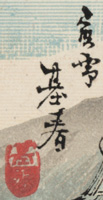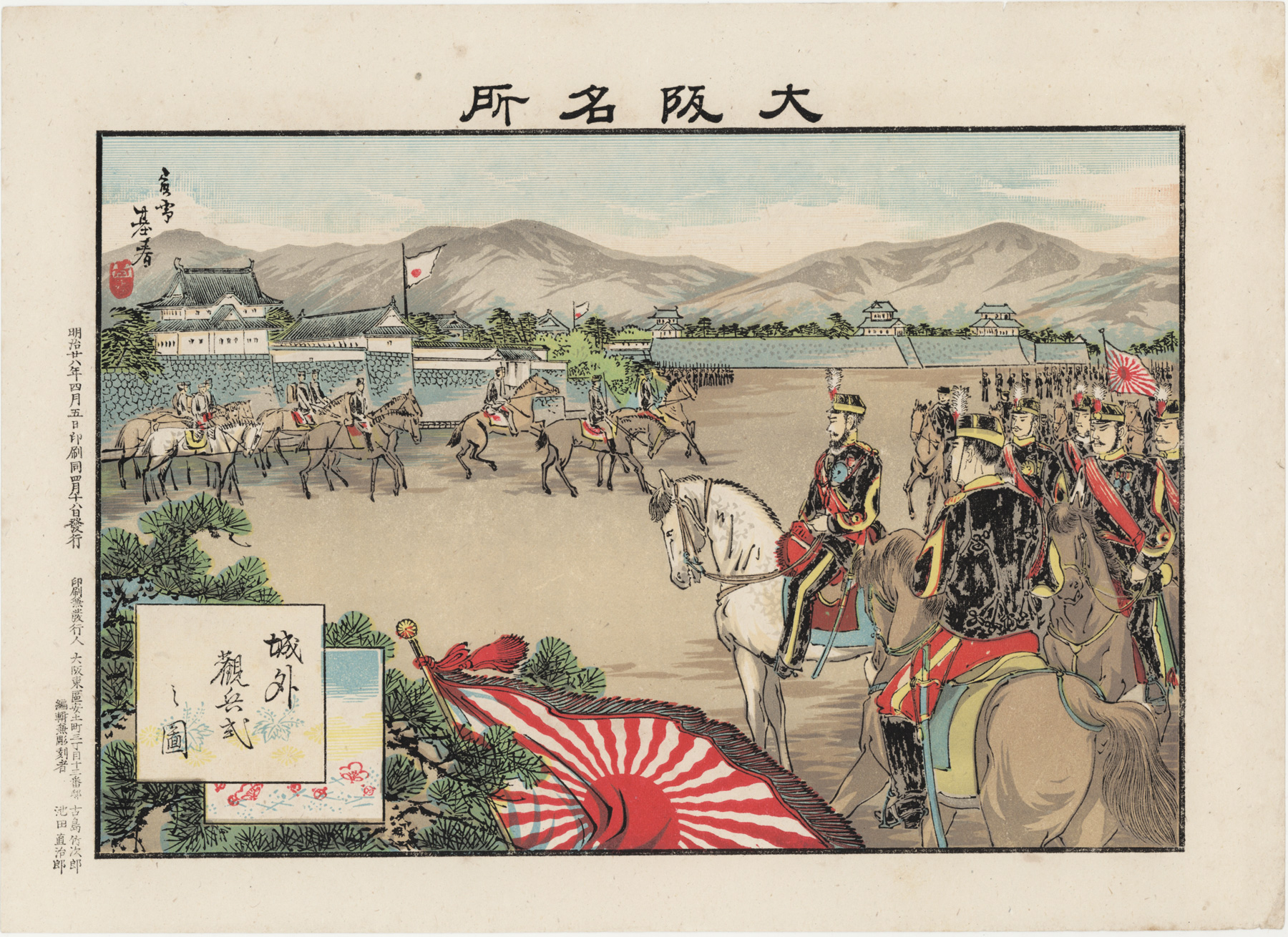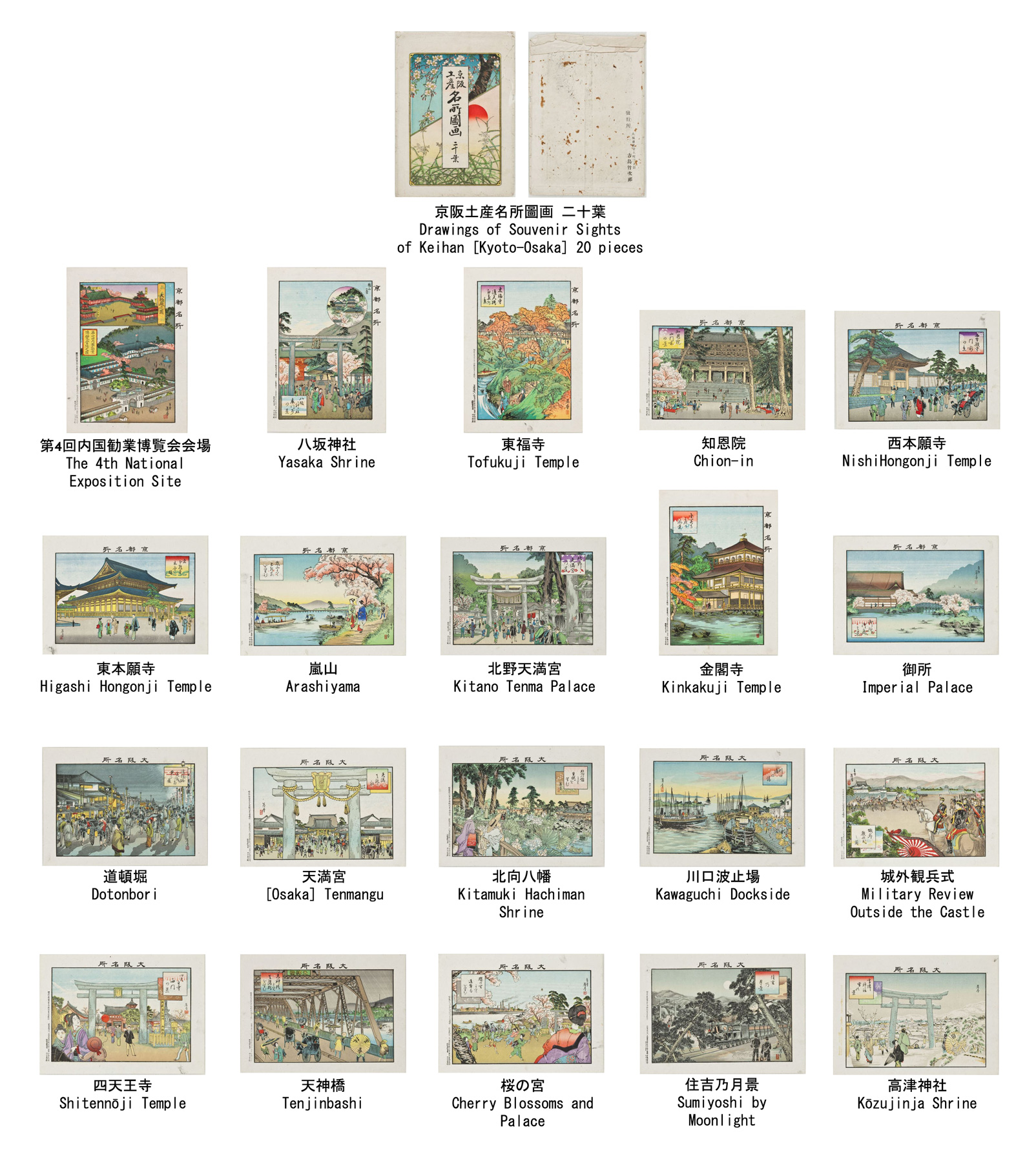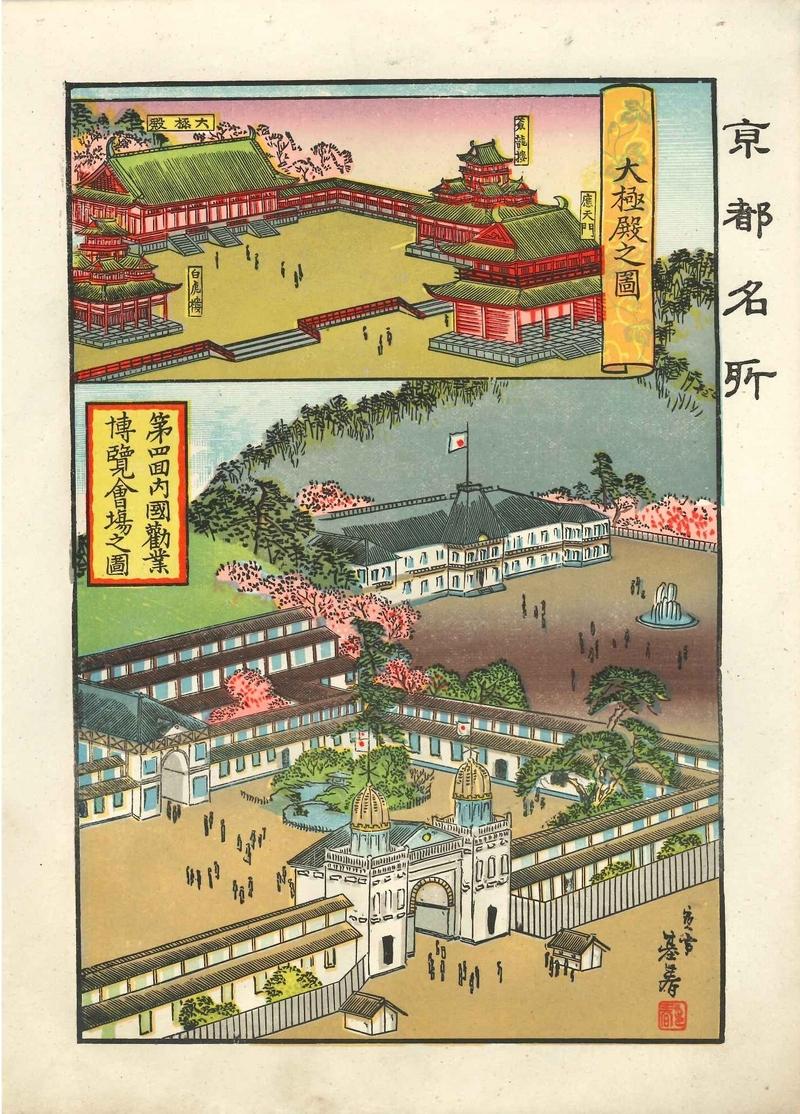About This Print
The Emperor reviews troops as they parade outside of Osaka Castle in this color lithograph, part of a twenty print portfolio published in April 1895 to coincide with the opening of the Fourth National Industrial Exhibition in Kyoto.About The Portfolio "Souvenir Drawings of Famous Sights of Keihan" [Kyoto-Osaka]
This portfolio of color lithographs 色石版画 consists of ten well-known scenes in Kyoto and ten scenes in Osaka. It was issued by the Osaka publisher Furushima Takejirō in 1895. This portfolio is the earliest use of color lithography, most likely using zinc plates, for the production of meisho-e, or pictures of famous places. The portfolio was sold in shops in the exposition hall and in souvenir/gift shops around Kyoto. The selling price and number of total copies is unknown, but it appears that at least two editions of this portfolio were produced. As over 1.3 million people attended the exposition, the print runs must have been quite large.
The Fourth National Industrial Exhibition in Kyoto
Source: National Diet Library website http://www.ndl.go.jp/exposition/e/s1/naikoku4.html
The Fourth National Exhibition Site from Souvenir Drawings of Famous Sights of Keihan | The Fourth National Industrial Exhibiition was held in Okazaki Park in Kyoto City from April 1, 1895 through July 31, 1895. It was the first industrial exhibition held in Japan outside of Tokyo. The host city of the fourth National Industrial Exhibition was Kyoto, which wished to overcome its sluggish conditions generated after the transfer of the Japanese capital to Tokyo. Initially, the fourth National Industrial Exhibition was planned for 1894. However, the people of Kyoto strongly hoped that the exposition would be held in 1895 as an event commemorating the 1,100th anniversary of the establishment of Kyoto. In 1894, the Sino-Japanese War broke out, but based on the judgment that industrial promotion was important even in war time, the government decided to hold the exposition in 1895 as scheduled. The venue was located to the south of Heian Jingu Shrine, with a total venue area of 178,000 m2, and a total structure site area of 47,000 m2. A marble fountain was constructed in front of the venue, and on both sides of the fountain was an array of shops. The main structures were the following six: the Fine Art Building, the Industrial Building, the Agricultural and Forestry Building, the Machinery Building, the Marine Production Building, and the Animal Building. At the Machinery Building, electricity replaced coal as the power source. In front of the Marine Production Building was the Exhibition Room of Aquatic Living Things, a facility |
At the Fine Art Building, Seiki Kuroda, a Japanese artist who had returned from France, exhibited a nude with the title of Chosho (Make up in the morning), (which was subsequently destroyed in a fire), arousing great controversy regarding the disturbance of public morals. Eventually, it was decided to continue the display of the picture on the condition that a part of the picture would be covered with a cloth. This controversy was featured in a cartoon by G. Bigot.
Another main feature of the exposition was that a streetcar was operated outside the venue as an official means of public transportation for the first time in Japan. The streetcar ran from Shichijo, Kyoto, to the area around the venue near Heian Jingu Shrine, and also to the vicinity of Lake Biwa Canal. Running southward to Fushimi, the electricity for the streetcar was powered by the water from the canal. It can be said that it served as a symbol of the coming of the electricity period. Although the exposition was somewhat controversial, it came to a highly successful end, drawing 169,098 items from 73,781 exhibitors, as well as welcoming 1,136,695 visitors. For the event, streets and accommodation were improved, providing the basis for Kyoto's establishment as a sightseeing destination.
Print Details
| IHL Catalog | #1946 |
| Title or Description | Illustration of Military Review Outside [Osaka] Castle 城外観兵式之圖 |
| Series | Souvenir Drawings of Famous Sights of Keihan [Kyoto-Osaka] 京阪土産名所図画 |
| Artist | Hayashi Motoharu (1858-1903) |
| Signature |  |
| Seal | unread (see above) |
| Publication Date |  printed: April 5, 1895 明治廿八年四月五日印刷 issued: April 18, 1895 同四月一八日発行 |
| Publisher |  印刷兼發行人 [printing and publishing] 大阪...[Osaka - address of publisher] 編輯兼彫刻者 [editing/compiling and engraving] 池田直治郎 [Ikeda Naojirō] [Marks: publisher not listed] Source: website of Stategic Management Laboratory Inc. https://sml.co.jp/documents/toppan-ichida.html?page=5 Furushima created both lithographs and woodblock prints and was a member of the Copperplate and Lithography Association of the Osaka Chamber of Commerce which had 27 companies listed as members in 1894. |
| Carver | not applicable |
| Printer | |
| Impression | excellent |
| Colors | excellent |
| Condition | excellent |
| Genre | kaika-e; meisho-e |
| Miscellaneous | 色石版画 color lithograph |
| Format | chuban |
| H x W Paper | 7 3/8 x 10 3/16 in. (18.7 x 25.9 cm) |
| H x W Image | 5 13/16 x 8 5/8 (14.8 x 21.9 cm) |
| Literature | |
| Collections This Print | Osaka Municipal Library 書誌ID 0000519413 [entire portfolio]; Yamagata Museum 資料番号 6C007465; Kainsai University Research Center for Cityscape and Cultural Heritage of Osaka [partial portfolio]; Kyoto Institute, Library and Archives 歴:地下1階書庫B K1||291.62||H48||/556886 |
7/15/2020
1/13/2019
12/26/2018




